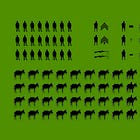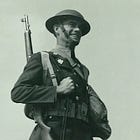Historical Map Problems
Decision-Forcing Cases
Between 1932 and 1939, the house journal of the Infantry School published a large number of “historical map problems.”1 Set in recent conflicts, these exercises put participants in the shoes of a real soldier who, at one time in the past, found himself faced with the need to deal with a series of particularly challenging challenges.
Upon encountering one of these conundrums, the reader was instructed to stop reading, and, with map in hand, compose the orders he would give in that situation. Having done this, he was free to compare his own response to the challenge with that of the soldier who encountered it in real life.
In his introduction to first set of historical map problems, the anonymous author defended the value of the historical solution. “In each case,” he wrote, “the solution given is that which was made by the leader at the time. It is possible that better solutions can be evolved. However, the solutions given, made under the strain of battle conditions, in each case met the existing situation and resulted in success under the supreme test of war.”2
Like much of the material in the Mailing List, the historical map problems made their way into print via the programs of instruction at the Infantry School. There, they complemented a program of “think on your feet” field exercises championed by, among others, George C. Marshall and the German exchange officer, Adolf von Schell.
An officer who served “under instruction” at the Infantry School in 1931 and 1932, described one of the latter exercises as follows:
“Marshall would make frequent visits to classes in the field, and we would, as a group, have an opportunity to hear him explain his views on the problems of the day. I remember occasions when he would outline a tactical situation to a group of students, then select a student and have him give a field order subject to critique by the other students and finally his observations. On one occasion we rode horses cross country over a 17-mile course and at the end, without previous warning, were told to draw a sketch map of the area covered.”3
In the months and years to come, the Tactical Notebook will publish a number of historical map problems. Some of these, such as A Skirmish in Nicaragua will be taken from the Mailing List. Others will be problems developed for, and tested by, members of the Decision Game Club.
For historical map problems already published in the Tactical Notebook, please see the Games page, which you can find in the navigation bar.
For Further Reading:
The Mailing List should not be confused with the Infantry Journal. While the former was an official publication of the US Army Infantry School at Fort Benning Georgia, the latter was published by a private organization, the United States Infantry Association.
Anonymous, “Infantry Problems (Foreword)”, The Mailing List, Volume IV (June 1932), page 53.
Letter of George H. Decker to Forrest Pogue, 5 November 1964, quoted in The Papers of George Catlett Marshall, Volume 1, “The Soldierly Spirit, December 1880June 1939 (Baltimore: The Johns Hopkins University Press, 1981), pages 319-321.






